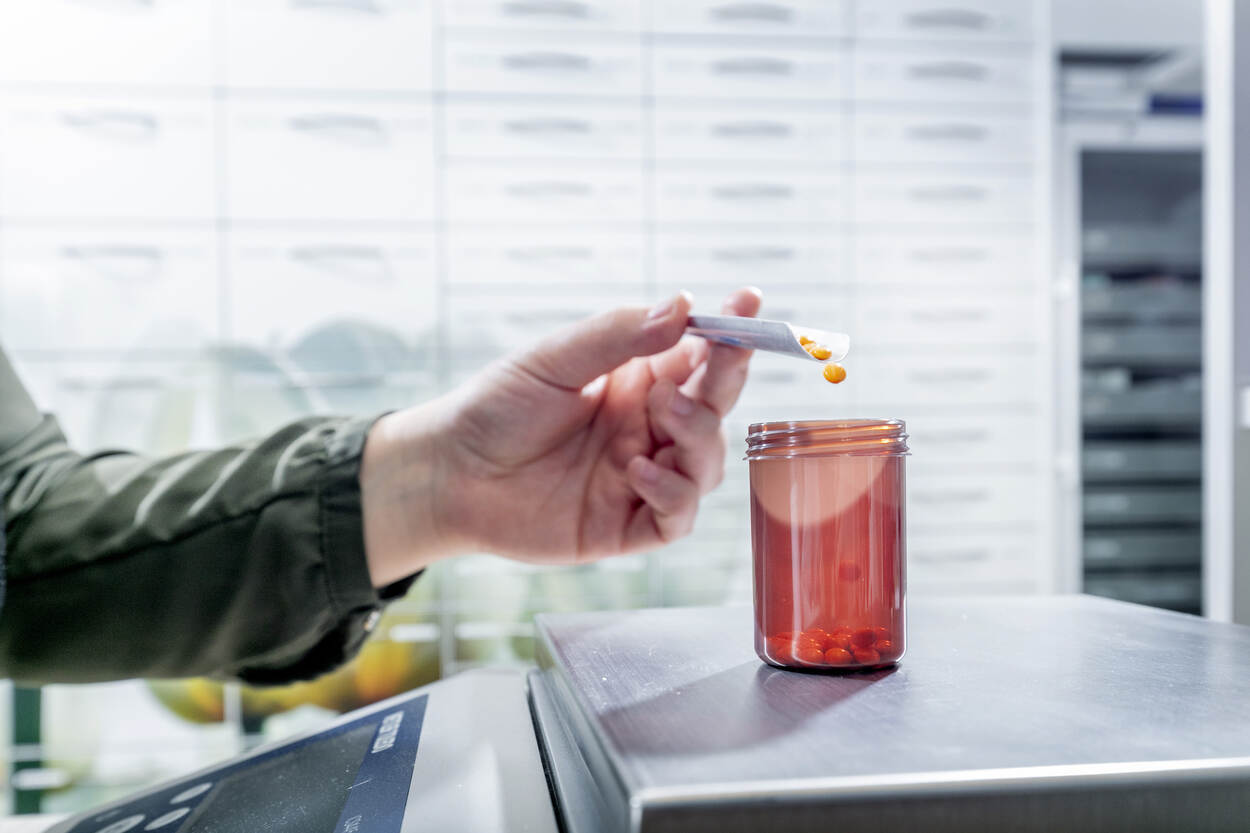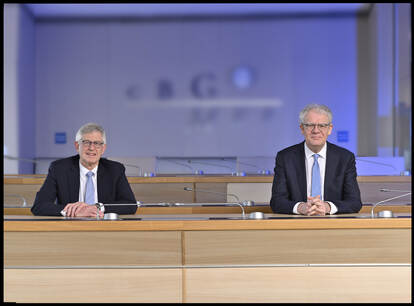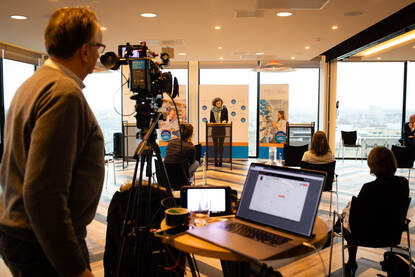In order to be allowed to introduce a medicine or vaccine for human use to the market, a pharmaceutical company requires a marketing authorisation. The various procedures that are available for obtaining a marketing authorisation for a medicine are discussed more specifically in the chapter ‘Procedures to introduce a medicine to the market’.
European committees
In the following two scientific committees of the European Medicines Agency (EMA), member states join forces in the assessment of medicines for human use within the framework of the European centralised procedure: the Committee for Medicinal Products for Human Use (CHMP) and the Pharmacovigilance Risk Assessment Committee (PRAC). Representatives of all EU countries have a seat in these committees. The committees convene every month at the EMA in Amsterdam. In 2020, the committees met remotely via video links due to the restrictions related to the COVID-19 pandemic.
If the Netherlands is the Rapporteur, the assessment of the dossier is carried out by a team of MEB colleagues. The composition of this team depends on the medicine and the topics involved in the assessment of the product. The outcomes of the assessment are then put before the Board, after which the Board decides with which proposal the Dutch CHMP or PRAC members will enter the discussion in the relevant committees.
The EMA has criteria in place for assigning rapporteurships and co-rapporteurships to ensure that this takes place based on the best available expertise in the member states. There is also room here for countries that have not been rapporteurs that often in the past.
The assignment of co-rapporteurships at the PRAC is different from that of the CHMP: the country that is CHMP Rapporteur automatically becomes the PRAC Co-rapporteur.
Besides the CHMP and the PRAC , there are four other scientific committees for medicines for human use in the centralised procedure at the EMA: the Committee for Orphan Medicinal Products (COMP), the Paediatric Committee (PDCO), the Herbal Medicinal Products Committee (HMPC) and the Committee on Advanced Therapies (CAT). Various working groups are active in each scientific committee of the EMA. One example is the Scientific Advice Working Party (SAWP).
The coordination of the European work in connection with the decentralised and mutual recognition procedures has been delegated to the Coordination Group for Mutual Recognition and Decentralised Procedures human (CMDh). The CMDh is a scientific committee of the member states but, like the other committees, convenes at the EMA and is also supported by the EMA.
Rapporteurships and co-rapporteurships assigned via the centralised procedure (CHMP)
The CHMP is also responsible for assessing centralised applications for marketing authorisations of medicinal products.
The number of rapporteurships and co-rapporteurships assigned to the MEB in 2020 decreased slightly compared to the previous year. In relative terms, the MEB’s share of the total number of rapporteurships in Europe remained unchanged at 12%. This is because fewer applications were received through the centralised procedure in 2020 than in 2019.
The MEB was assigned the most rapporteurships and co-rapporteurships in 2020, as it was in the previous year. Of the 30 participating European countries, five were not assigned any rapporteurships or co-rapporteurships in 2020. One of those five countries is the United Kingdom; it was still involved in European procedures in 2020 during the transition period, but was no longer allowed to take on any rapporteurships or co-rapporteurships due to Brexit.
Rapporteurships and co-rapporteurships assigned
| Co-rapporteur | Rapporteur | |
|---|---|---|
| 2016 | 4 | 8 |
| 2017 | 6 | 7 |
| 2018 | 5 | 18 |
| 2019 | 11 | 24 |
| 2020 | 10 | 19 |
Rapporteurships and co-rapporteurships assigned
| Country | Number |
|---|---|
| Austria | 17 |
| Belgium | 4 |
| Bulgaria | 0 |
| Cyprus | 0 |
| Czech Republic | 8 |
| Germany | 25 |
| Denmark | 16 |
| Estonia | 6 |
| Greece | 3 |
| Spain | 9 |
| Finland | 8 |
| France | 19 |
| Croatia | 5 |
| Hungary | 4 |
| Ireland | 11 |
| Iceland | 4 |
| Italy | 2 |
| Lithuania | 0 |
| Luxemburg | 0 |
| Latvia | 8 |
| Malta | 1 |
| Netherlands | 29 |
| Norway | 4 |
| Poland | 10 |
| Portugal | 4 |
| Romania | 7 |
| Sweden | 18 |
| Slovenia | 5 |
| Slovakia | 5 |
| United Kingdom | 0 |
More European cooperation
The MEB also plays an important role in multinational assessment teams, the MNATs. In these teams, a rapporteurship is carried out jointly by several countries so that countries with less experience in rapporteurships also have the opportunity to gain experience. Of the 19 rapporteurships assigned to the MEB in 2020, 13 were assigned as MNATs. In most cases, the participating country took responsibility for assessing the quality aspects of the medicine within the MNAT. Never before was the MEB involved in so many MNAT collaborations. It promoted European cooperation (see also the International Collaboration Program section), and helped the MEB to manage its very high workload, particularly in the area of quality assessment.
MEB-ZIN Parallel Procedures pilot
In the MEB-ZIN Parallel Procedures pilot, together with the umbrella organisations the Association for Innovative Medicines (VIG) and HollandBIO, a working method was developed for more parallel procedures for authorisation and reimbursement instead of the current sequential procedures. This means that the assessment for reimbursement starts while a medicine is being assessed for authorisation. As a result, the reimbursement status for the medicine is clear shortly after authorisation. To make this possible, the working method is being further developed and tested in a number of pilot procedures (authorisation and reimbursement procedure of a medicine).
Four medicines have been formally included in the pilot thus far. The assessments for two of those medicines have been completed, and the other two will be assessed in the near future. In addition, talks are being held with several manufacturers in order to also assess other medicines using the parallel method.
This method has proven to be clear, predictable and practically feasible for the MEB, the National Health Care Institute (ZIN) as well as the pharmaceutical industry. In addition, the first pilot procedures show that clarity on the reimbursement status of medicines assessed in parallel is available three months earlier. The MEB and ZIN intend to implement the parallel procedure structurally in the future.
Assigned pharmacovigilance rapporteurships (PRAC)
The Pharmacovigilance Risk Assessment Committee (PRAC) plays an important role in terms of supervising the risks of medicinal products for human use in Europe. The PRAC makes recommendations to the CHMP and the CMDh about the risks of medicinal products which are or will be authorised in the European Union.
Assigned pharmacovigilance rapporteurships
| Country | Number |
|---|---|
| Austria | 7 |
| Belgium | 5 |
| Bulgaria | 0 |
| Cyprus | 0 |
| Czech Republic | 5 |
| Germany | 15 |
| Denmark | 8 |
| Estonia | 0 |
| Greece | 0 |
| Spain | 2 |
| Finland | 5 |
| France | 9 |
| Croatia | 3 |
| Hungary | 0 |
| Ireland | 1 |
| Iceland | 0 |
| Italy | 5 |
| Lithuania | 0 |
| Luxemburg | 0 |
| Latvia | 1 |
| Malta | 2 |
| Netherlands | 20 |
| Norway | 1 |
| Poland | 3 |
| Portugal | 6 |
| Romania | 0 |
| Sweden | 19 |
| Slovenia | 2 |
| Slovakia | 0 |
| United Kingdom | 0 |
Assigned pharmacovigilance rapporteurships
| Other | New substances | |
|---|---|---|
| 2016 | 9 | 10 |
| 2017 | 0 | 14 |
| 2018 | 5 | 11 |
| 2019 | 12 | 19 |
| 2020 | 9 | 11 |
In 2020, the MEB was assigned fewer PRAC rapporteurships than in the previous year. This is mainly because there were 20% more PRAC rapporteurships to distribute in 2019 than in 2020. Of the 20 PRAC rapporteurships assigned to the MEB, 11 were for new active substances. The other rapporteurships concerned generics and biosimilars.
With 20 PRAC rapporteurships, the MEB continues to play a leading role in Europe. Notably, the Netherlands, Germany and Sweden together account for almost half of the PRAC rapporteurships.
Furthermore, the MEB is responsible for the pharmacovigilance of 99 active substances in a European context. This means that for these substances, the MEB is responsible for analysing data in the European database of suspected adverse reactions, the EudraVigilance database, and for identifying signs of possible new or changed risks.
Initialised applications via the decentralised procedure (DCP) and mutual recognition procedure (MRP)
The number of procedures initiated in which the Netherlands was the reference member state (RMS) decreased slightly compared to 2019.
It is noteworthy that, within Europe, the Netherlands and Germany, with 174 and 232 initiated DCP applications respectively, together coordinate approximately 40% of all DCP procedures.
Initialised applications via the decentralised procedure (DCP) and mutual recognition procedure (MRP)
| MRP | DCP | |
|---|---|---|
| 2016 | 61 | 243 |
| 2017 | 70 | 230 |
| 2018 | 57 | 211 |
| 2019 | 60 | 235 |
| 2020 | 85 | 174 |
Initialised applications via the decentralised procedure and mutual recognition procedure
| Country | DCP and MRP |
|---|---|
| Austria | 72 |
| Belgium | 1 |
| Bulgaria | 0 |
| Cyprus | 5 |
| Czech republic | 59 |
| Germany | 278 |
| Denmark | 84 |
| Estonia | 27 |
| Greece | 0 |
| Spain | 21 |
| Finland | 30 |
| France | 1 |
| Croatia | 14 |
| Hungary | 56 |
| Ireland | 34 |
| Iceland | 24 |
| Italy | 3 |
| Lithuania | 6 |
| Letland | 12 |
| Malta | 43 |
| Netherlands | 259 |
| Norway | 9 |
| Poland | 23 |
| Portugal | 111 |
| Romania | 1 |
| Sweden | 103 |
| Slovenia | 15 |
| Slovakia | 13 |
| United Kingdom | 12 |
International Collaboration Program
2020 marked the third year of the International Collaboration Program (ICP). The 10 participating countries receive contributions (as needed) for salaries of newly recruited assessors, support with regard to training, professional technology (almost everything was digital in 2020), and customisation for support in ongoing procedures, reviews and peer reviews. Participating countries are now participating fully in MNATs (for centralised applications) and other forms of cooperation. Due to the COVID-19 pandemic, periodic trips to ICP countries have been postponed and collaboration takes place more in digital form. The emphasis is on assessments of medicines for human use, but there is also collaboration with regard to inspections. International activities have also been initiated for veterinary medicines, including activities in the area of antibiotic resistance.
Collaboration within the ICP is now working both ways. A number of ICP countries support the MEB in assessing procedures when there is insufficient capacity at the MEB. Unless the programme is extended with government funds allocated for international cooperation, 2021 will be the last year of the ICP.
Applications via the national procedure
The number of submitted national applications (excluding parallel import and including duplex procedures) increased further in 2020 compared to the previous years. This increase is mainly attributed to an increase in the number of duplex procedures submitted (58 in 2020 compared to 43 in 2019). A duplex authorisation is an authorisation of a product, for which the dossier is identical to that of a product that has already been authorised. In a duplex authorisation procedure, the MEB may decide not to perform a full assessment so that the marketing authorisation can be issued quickly.
However, the number of applications through the national procedure remains low in absolute numbers. In the majority of cases, applicants prefer a European procedure (centralised and DCP) so that the product can be introduced to the market in several European countries.
Applications via the national procedure
| 2016 | 2017 | 2018 | 2019 | 2020 | |
|---|---|---|---|---|---|
| Number of applications | 46 | 66 | 57 | 67 | 87 |
National parallel import applications
The sharp decrease in parallel import applications in 2019 continued in 2020.
National parallel import applications
| 2016 | 2017 | 2018 | 2019 | 2020 | |
|---|---|---|---|---|---|
| Numer of applications parallel import | 428 | 445 | 521 | 375 | 316 |
Number of registered marketing authorisations
After a small increase in the number of marketing authorisations issued in the Netherlands in previous years, there was a clear decrease in 2020. Whereas in previous years the number of authorisations per year was consistently slightly higher than the number of withdrawals in that year, this was not the case in 2020. Not only was the number of withdrawals significantly higher in 2020 than previous years (see chart Withdrawals), the number of marketing authorisations issued in 2020 was also about 30% lower than in previous years.
Number of registered marketing authorisations
| 2016 | 2017 | 2018 | 2019 | 2020 | |
|---|---|---|---|---|---|
| Number of registered marketing authorisations | 14060 | 14133 | 14288 | 14288 | 13565 |
Withdrawals
If a pharmaceutical company submits a request for a withdrawal, it is examined whether this concerns a critical product; for example, whether there are no comparable products in the same group of medicines. If this is not the case, the MEB will explore which other possibilities there are to retain the product for the Dutch market. The MEB will do this in consultation with the marketing authorisation holder.
Withdrawals
| 2016 | 2017 | 2018 | 2019 | 2020 | |
|---|---|---|---|---|---|
| Number of withdrawals | 1056 | 1246 | 1209 | 1390 | 1649 |
Number of concluded cases (including variations)
The MEB handles hundreds of cases every week; from marketing authorisation applications and applications for indication extensions to smaller variations, such as changing a manufacturer in the dossier, adding an adverse reaction or changing the shelf life of a medicine.
The number of cases concluded by the MEB increased slightly compared to 2019. There was a substantial increase last year, due in part to the increase in the number of cases related to medicine shortages.
Number of concluded cases
| 2016 | 2017 | 2018 | 2019 | 2020 | |
|---|---|---|---|---|---|
| Number of concluded cases | 18058 | 19666 | 25071 | 28959 | 29521 |
Scientific advice
By providing scientific advice, the MEB contributes to the responsible development of medicines, to innovation and to early patient access. Scientific advice can concern all aspects of product development, such as clinical or toxicological aspects, as well as regulatory aspects. The advice serves to provide investment security and is therefore a statutory task. There are both national and centralised (European) procedures for providing scientific advice. As a statutory task, providing national advice falls under the direct responsibility of the Board. Centralised scientific advice is prepared by the SAWP and concerns a European consensus. The MEB is active in both types of scientific advice (European and national).
Number of assigned scientific advice requests in Europe involving the MEB
In 2020, the MEB was again involved as the coordinator in a large number of European scientific advice requests (Lead assessor Member State). Of the advice requests in which the Netherlands was involved, 10 concerned a COVID-19 medicine or vaccine.
Number of assigned scientific advice requests via SAWP
| 2016 | 2017 | 2018 | 2019 | 2020 | |
|---|---|---|---|---|---|
| Number of assigned scientific advice requests via SAWP | 106 | 135 | 130 | 142 | 140 |
Number of national scientific advice requests
The number of national scientific advice requests in 2020 decreased slightly compared to 2019, with a particular decrease in the number of requests received in the last quarter of 2020 compared to the previous years. This may be due to a shift in priorities in the pharmaceutical industry due to the COVID-19 pandemic. In general, interactions between developers and the MEB were negatively impacted by the lockdown in 2020.
The MEB also provides customised advice, in which start-ups, small companies and scientific university groups are offered the possibility to request advice at a reduced rate. Providing this type of advice stimulates innovation at universities and small companies. As part of this customised advice, a special category for COVID-19 advice was created in 2020 in response to the COVID-19 pandemic. This advice is intended to support research involving the testing of medicines and vaccines for the potential treatment and prevention of COVID-19. These requests for advice are expedited and are free of charge for the applicant. Three applications for COVID-19 advice were received in 2020.
As in previous years, the MEB also actively involved in the drug-rediscovery projects of ZonMw (the Dutch institute that stimulates and finances healthcare research and innovation). With these assessments of project applications for research into medicinal products, which are sometimes already used off-label, the MEB contributes to possible on-label use by registering the use in question. This provides important advantages for prescribers and patients (the registered use forms part of the product information, including the package leaflet) and for the pharmacovigilance.
In addition, previous initiatives, such as providing joint scientific advice with the National Health Care Institute (ZIN) and the Central Committee for Research Involving Human Subjects (CCMO), were continued despite staffing problems.
A new initiative in 2020 concerned the involvement of patients or patient representatives in national scientific advice. In this pilot, a total of 5 cases of scientific advice involved a patient representative in 2020.
Number of national scientific advice requests
| Scientific advice | Customised advice (including COVID-19 advice) | |
|---|---|---|
| 2016 | 78 | 12 |
| 2017 | 101 | 12 |
| 2018 | 110 | 6 |
| 2019 | 115 | 14 |
| 2020 | 103 | 10 |
Adverse reactions
Signalling and assessing adverse reactions of a medicinal product, also when the product has already been authorised, is one of the MEB's core tasks. At the MEB's request, the Netherlands Pharmacovigilance Centre Lareb collects, registers and analyses reports of suspected adverse reactions from medical professionals and patients. Lareb discusses relevant findings from these analyses with the MEB.
Lareb and the MEB discussed 62 analyses of reports of suspected adverse reactions in 2020, of which 15 were elaborated for discussion in the Board meetings and 3 in the Medical Practice Committee of the MEB. The other analyses were also followed up through ongoing procedures at the MEB and through the continuous monitoring of the reports.
As stated earlier in this chapter, the MEB is responsible for the signal detection of 99 active substances (or combinations of active substances) in a European context. In addition, the MEB is a PRAC Rapporteur for 102 active substances (or combinations of active substances). For these substances, the MEB assesses all signals of potential new or changed risks. In 2020, the MEB assessed 15 signals in the European context.
The MEB is also responsible for the assessment of Periodic Safety Update Reports (PSUR) of these active substances, within the PSUR Single Assessment (PSUSA) procedure. A PSUR is a comprehensive and critical analysis of the benefit-risk balance of a product. It provides medicines authorities with an update on global experiences with the safety of a product at set intervals after authorisation. The submission of a PSUR is determined through a risk-based approach. The frequency with which PSURs must be submitted varies. The MEB conducted 88 PSUSA assessments on behalf of Europe in 2020.
Lareb signals
| Discussed in board | In Medical Practice Committee | Other | |
|---|---|---|---|
| 2018 | 11 | 3 | 36 |
| 2019 | 16 | 2 | 47 |
| 2020 | 15 | 3 | 44 |
Direct Healthcare Professional Communication
In the event of urgent and/or important safety issues, healthcare professionals are informed by means of a letter, referred to as a Direct Healthcare Professional Communication (DHPC). A total of 22 DHPCs were sent in 2020.
Direct Healthcare Professional Communications
| 2016 | 2017 | 2018 | 2019 | 2020 | |
|---|---|---|---|---|---|
| Number of DHPC's | 30 | 21 | 31 | 29 | 22 |
Shortages
The Medicine Shortages and Defects Notification Centre received 3,723 notifications of expected supply problems for a total of 2,079 different medicines in 2020. This is about 6% more than in 2019; in that year, notifications were received for 1,965 different medicines.
Almost half (48%) of the supply problems were caused by delays in production or release of the finished product. Companies also cited this as the main reason in previous years. Supply problems due to an increase in demand also played an important role (28%). This increase is usually due to a supply problem for a similar medicine at one or more other companies.
For each notification, the Notification Centre checks whether alternatives are available in the Netherlands. This is the case for many medicines, allowing delivery problems to be dealt with. An appropriate solution was available to patients for 99% of medicines that were temporarily unavailable.
Shortages and the coronavirus
At the beginning of the COVID-19 pandemic, there was uncertainty and concern about the impact on medicine availability. For example, due to logistical challenges and reduced production as a result of lockdowns in India and China. In addition, export bans on pharmaceutical ingredients and finished products applied in some parts of the world for a certain period of time. Furthermore, hoarding resulted in supplies of medicines in community pharmacies and chemists selling more quickly than usual.
The Ministry of Health, Welfare and Sport took various precautions and other measures in cooperation with the IGJ, the MEB and parties in the field in order to ease concerns and prevent shortages. For example, for a period of 6 months, the MEB and parties in the field carried out weekly monitoring of the stocks and use of medicines that play an important role in the treatment of COVID-19. Thanks to various efforts, major medicine availability problems were avoided. However, international developments continue to be closely monitored.








